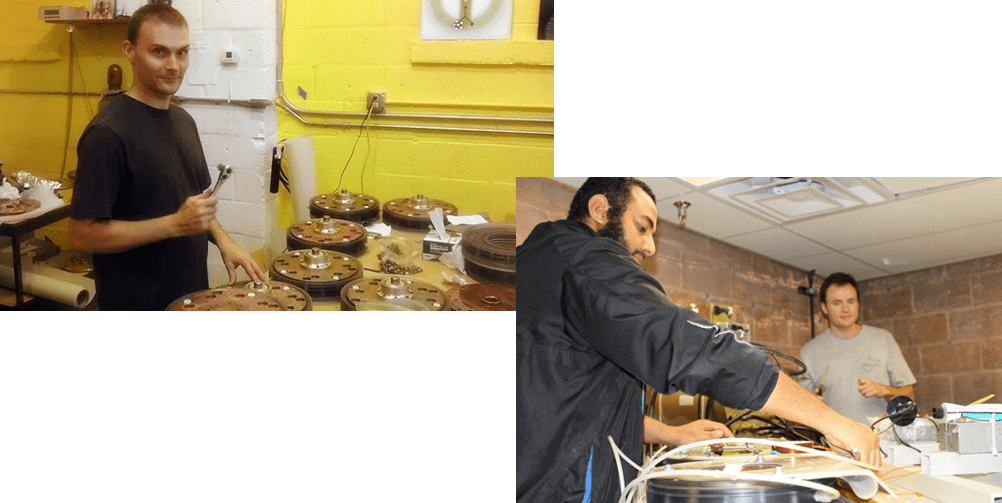A new era for reliability: Complete set of 12 re-designed switches passes all tests with flying colors, ready for higher voltages.
Complete switch system fires simultaneously 18 times in a row with no misfires or prefires; New switches pass all tests at 35 kV and 40 kV
Additional background on LPP’s switches at the Focus Fusion Society
In a major step forward for the Focus Fusion-1 experiment, LPP researchers succeeded in firing the entire bank of 12 capacitors simultaneously through our new “Mark 12” spark-gap switches. On August 7-8, the team fired the bank successfully 18 times in a row. During this series, there were no missed fires by any switch and there were no prefires–A prefire is when a switch spontaneously fires before it is triggered by the device operator. All switches fired within 40 ns of each other, and most switches fired within 10 ns of each other. While too few shots have been fired to determine the lifetime of the new switches, wear so far has been minimal.
Left: LPP Advisor Bob Fitzgerald smiles his approval for the upgraded FoFu-1 during a visit to the lab, 8-6-2011. Right:The full complement of twelve new spark plugs.
Why is this latest switch success so important? The capacitors send energy through these switches into FF-1’s electrodes to create the filaments of current that then converge and compress themselves into the dense plasmoid. This tiny plasmoid is where the majority of fusion reactions occur. It is important that the switches all fire simultaneously so that the sheath of current filaments is symmetrical. Any asymmetry can cause some filaments to get ahead of others, preventing full compression of the plasmoid. The more the plasmoid is compressed, the faster the fusion fuel burns and the more energy is produced, so symmetry is critical. Having all the switches fire together within tens of nanoseconds helps achieve this symmetry.
The poor performance of the FF-1’s original switches, purchased from R. E. Beverly, had substantially slowed the Focus Fusion research project. The new switches, designed in January by LPP, use only the old insulators and otherwise have all new parts. While fabrication of such unique components took time, the improved performance has been worth the wait.
The successful switch firings were with the capacitors charged to 35 kV. The LPP team feels very confident that the switches will work well up to the full capacitor bank potential of 45 kV. For one thing, the operating pressure of the gas in the spark gaps was far less than the switches’ limit. So even at 45 kV, the gas pressure, which rises with voltage, will be much below that limit. Second, the switches passed a static test to see if they would spontaneously breakdown (pre-fire) at 40 kV. In late August, LPP expects to do further tests of the switches all the way up to 45 kV.
Left: LPP’s Aaron Blake installs the new switch plates into the insulators that will hold back the capacitors’ charge until the crucial moment of firing. Right: Visiting Kansas State University grad student Amgad Mohamed (foreground) and LPP’s Derek Shannon re-install the transition plates that will transfer the current from the switches to the central electrodes.


